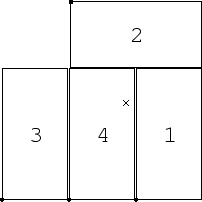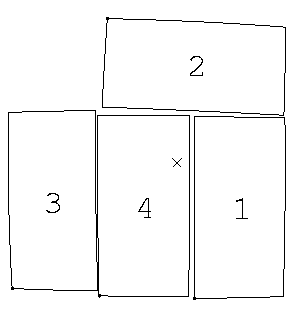
The Wide Field Camera instrument on the Isaac Newton Telescope contains four CCD chips of 2048 4096 pixels positioned roughly, but not exactly, as shown in figure 1.
In order to do accurate astrometry with data obtained from this instrument, it is necessary to correct for the exact orientation and position of each CCD in relation to the others, as well as for nonlinear distortions away from the optical axis of the focal plane introduced by the optics of the telescope. The nonlinear distortion is very well modelled by a radial “pincushion” transformation, which has the form
The following transformations take account of both these effects to map the pixel coordinates of CCD# into a new pixel-like coordinate system of uniform scale, which is the same for all four CCDs. The origin of this coordinate system is at pixel coordinates of CCD#4, which is taken to be on the optical axis. At this point, one unit of the new coordinate system is equivalent to one pixel of the CCD#4 system, so that the new coordinates are almost equivalent to CCD#4 coordinates, although they diverge away from the origin thanks to the nonlinear distortion. Each unit of the new coordinates has the same size, which is approximately 0.333 arcsec.
The corrected coordinates are obtained from each set of pixel coordinates by first translating so that the origin is on the optical axis, then rotating to the correct angle, then correcting for the radial distortion effect:
Where are the coordinates of the optical centre of the instrument in the pixel coordinate system of CCD#, is the angle at which CCD# sits on the focal plane, and is the pincushion distortion coefficient.
Values for these coefficients have been obtained by registering two exposures of the same region of sky, in which the instrument had been rotated by 180 between exposures. The value of was taken from the value used for the Wide Field Survey data, and was chosen to be zero. The values of the coefficients in these equations are approximately:
and
This value of corresponds in units of radians to -203 rad, compared to the value -259.8 rad quoted in the ING observer handbook.
These values of the coefficients are thought to be correct to an accuracy of 1 or 2 pixels, which is around half an arcsecond.
Figure 2 gives an exaggerated representation of the shapes and positions of the CCDs as mapped on to the new coordinate system.
